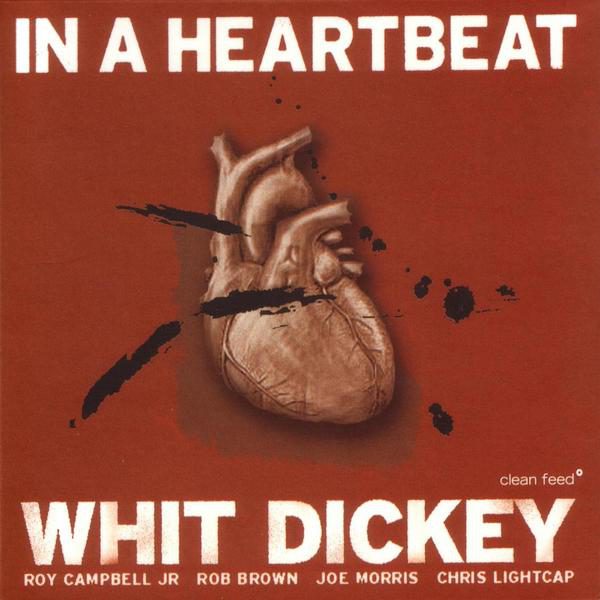
Whit Dickey
Personnel:
Chris Lightcap (b), Joe Morris (g), Rob Brown (as), Roy Campbell Jr. (t), Whit Dickey (d),
Also available on iTunes
€ 8.90
Every Whit Dickey’s recording shows the public a new concept of this band which is becoming cyclically deeper and reorganised in order to be considered in such a way. It occurred in Transonic (1998), With Dickey’s first album as a leader, it happened too in Big Top and Coalescence, and in what concerns In a Heartbeat, it is also true. This is not magic but work, commitment and organization. This strategy defines the production of In a Heartbeat. It is a global process that requires, of the members of the quintet, more than simple complicity and convergent orientation: a synergetic musical creation in which, by definition, the final product is superior to the sum of its parts. In this case, the parts are Rob Brown, alto saxophone; Roy Campbell, trumpet; Joe Morris, guitar; Chris Lightcap, contrabass, and Whit Dickey who signs all the compositions, except the opening theme composed by Carla Bley, and also guarantees the chromatic and propulsive components of percussion. These four musicians are Dickey’s habitual fellows on jazz/ improv scene in New York. These musicians keep with each other a relationship not based on hierarchical values, but on a kind of equalitarianism. In that way, each voice, based in its own individuality and diversity, assures the time and the space which are essential to the individual expression and to the contribution for the collective sound. Whit Dickey’s musical composition, further its function to frame the activity of the quintet, is based on a deep practical knowledge, a capacity of interaction and interdependence, which are the essential conditions for the process of evolution. These starting points, which put on the same level the first written composition and the one that comes from the prompt improvisation, confirm the creative process, grant a big sense of originality, and establish distinctive signs of appurtenance to a higher stage of development of modern improved music. Composition by composition, all work is divided in a series of activities or processes. Each process links up with another one and the result of the first process is the work material of the next; they are all connected by the solidity of the arrangements, and each of them cannot be independent or undissociable from the others. With Dickey, a master of drums, has a characteristic sound from which stands out a homogeneous mixture between strength, sensitivity and fluidity of time, emotional intensity and formal rigour, texture and volume, and a variety of tempos. He has deeply assimilated these characteristics during the time he was in David S. Ware’s quartet, from where he left to put into practice the purpose of giving sense to the necessity, from the inside, of composing and directing his own compositions. Rob Brown and Dickey have one of the best and proficient musical relationships. In a figurative way, Rob Brown strikes the match, which represents the collective animated discourse; he is skilled at connecting logically the different musical lines, made by the sounds, amid the light and the shadow of Roy Campbell’s trumpet, Joe Morris’s pointillist guitar, and the fluidity of Chris Lightcap’s contrabass. They are masters on managing the time and the space which they have or add some more in benefit of common effort which is different attending the multiplicity of rhythmic models and melodic phrases; these qualities stand out their individuality from a bunch of performers of the same instruments. According to this, With Dickey Quartet’s music is more than the reproduction or updating of forms, which has been defined for the publication of Transonic, seven years ago. Indeed, what is listened in In a Heartbeat comes from an internal discussion and a collective maturity based on individual experience, under a glance of consciousness on present jazz development. The superior levels of artistic creation evident in In a Heartbeat are the result of desire and enthusiasm of playing and sharing the music with the public. It guarantees appreciative opinions as a consequence of the artistic maturity and creative ambition, two real motives for the aesthetic progress. By Eduardo Chagas March, 2005
More music that may interest you